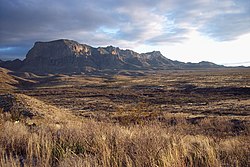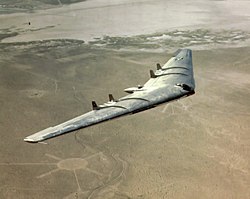Quetzalcoatlus
Quetzalcoatlus [1] is a genus of giant pterosaur, the largest animal ever to fly. The largest individuals measured a size of 10 to 12 meters wing-span (33-40 feet),[2] but was light in construction (~200 pounds).[3] Quetzalcoatlus had an unusually long neck, and when it stood on the ground it was as tall as a giraffe. Its fossil record is from the Late Cretaceous of North America, between 68 to 66 million years ago. Quetzalcoatlus became extinct at the K/T extinction event.
| Quetzalcoatlus Temporal range: Late Cretaceous,
| |
|---|---|

| |
| Skeleton reconstruction in the Royal Ontario Museum. | |
| Scientific classification | |
| Kingdom: | |
| Class: | |
| Order: | |
| Suborder: | |
| Family: | |
| Genus: | Quetzalcoatlus Lawson, 1975
|
| Type species | |
| †Quetzalcoatlus northropi Lawson, 1975
| |
| Species | |
|
†Q. northropi Lawson, 1975 (type) †Q. lawsoni Andres and Langston, 2021 | |
The genus include two valid species, the type named as Q. northropi and the recent named Q. lawsoni. The Q. lawsoni is the smaller species, with a maximum size of 4.5 to 6 m (11.5-19.6 ft) in lenght, and a weight probably up to 30 kg (66.1 lbs). He was not a dinosaur, but was related. Quetzalcoatlus coexisted with the massive theropod Tyrannosaurus rex.[4][5]
Its discovery
A college student found the first Quetzalcoatlus fossil in Big Bend National Park in Texas. His name was Douglas Lawson, from the University of Texas in Austin. When he was in the park, he saw a bone sticking out of a rock. Since the bone looked hollow, like the bone of a bird, he thought it was part of a flying creature – and he was right. With his professor's help, he kept digging until lots of bones from an arm and wing were found. The rest of the animal's body was missing.[6] Many others have looked for the rest of that huge pterosaur, but it has never been found. Other fossils of Quetzalcoatlus have been found, but none are as big as the one Lawson found.
Flight
Since Quetzalcoatlus was so large, two researchers suggested it was too heavy to fly.[7] This would have been astonishing, because in the whole fossil record there is no flightless pterosaur. It has been thought their mobility on the ground was too poor for them to survive without flight. However, a recent discussion of this idea concluded they probably could fly after all. Another analysis suggested their flight was quite strong.[8] Since we have only a few bones, the question of weight cannot be settled at present.[9]
Lifestyle
The feeding habits of Quetzalcoatlus (which had a long beak with no teeth) are unknown. This question, and its flight, are still being discussed. The lack of a more detailed skeleton is the main problem in reaching conclusions. Two theories have been proposed.
One idea is that it ate fish, by flying with its jaw in the water, and snapping up fish when it hit them. Texas was largely covered by the Western Interior Seaway at the time. "Of these proposed lifestyles, in-flight piscivory [fish-eating] appears to have gained the most acceptance, with skim-feeding being a frequently suggested foraging method.[8]
The other theory is that it fed on land, partly as a carrion feeder, like vultures and buzzards, and foraged for small animals.[8] This view is gaining ground, because the jaw does not show the adaptations for skimming found in modern birds who catch fish this way.
In flight, it was certainly a soarer, flying on up-currents of air in a warm environment, and its remains come from a site which was far inland in the Cretaceous.[10]
Media
Quetzalcoatlus was shown in the movie When Dinosaurs Roamed America eating a dead Triceratops carcass.
Quetzalcoatlus Media
The known fossils of Quetzalcoatlus were discovered in Big Bend National Park, Texas
The name of Q. northropi refers to its similar appearance to aircraft designed by John Knudsen Northrop
Skeleton reconstruction of Quetzalcoatlus at the Texas Science and Natural History Museum, originally mounted by Langston in the 1980s
Life reconstruction of 'Q'. lawsoni.
FSAC-OB 14, a vertebra assigned to aff. Quetzalcoatlus
Specimens of Cryodrakon, once considered to represent Quetzalcoatlus
Speculative life reconstruction of Q. northropi
References
- ↑ The word comes from the Aztec language, and is the name of a Mesoamerican deity meaning 'feathered serpent'. It's pronounced something like 'Ketzal-ko-atlus'.
- ↑ Langston, W. 1981. Pterosaurs, Scientific American, 244: 122-136.
- ↑ Atanassov, Momchil N.; Strauss, Richard E. (2002). "How much did Archaeopteryx and Quetzalcoatlus weigh? Mass estimation by multivariate analysis of bone dimensions". Society of Vertebrate Paleontology.
{{cite journal}}: CS1 maint: multiple names: authors list (link) - ↑ Lawson, Douglas Allan (1972). Paleoecology of the Tornillo Formation, Big Bend National Park, Brewster County, Texas. University of Texas at Austin.
- ↑ Lua error in Module:Citation/CS1/Identifiers at line 630: attempt to index field 'known_free_doi_registrants_t' (a nil value).
- ↑ Lawson D.A. 1975. Pterosaur from the latest Cretaceous of West Texas: discovery of the largest flying creature. Science 187: 947-948.
- ↑ Henderson D.M. 2010. Pterosaur body mass estimates from three-dimensional mathematical slicing. Journal of Vertebrate Paleontology, 30(3): 768-785.
- ↑ 8.0 8.1 8.2 Witton M.P., and Naish D. 2008. A reappraisal of Azhdarchid Pterosaur functional morphology and paleoecology. PLoS ONE, 3(5): e2271. doi:10.1371/journal.pone.0002271 Full text online Archived 2014-12-17 at the Wayback Machine
- ↑ Minogue, Kristen 2010. Large size did not keep pterosaurs grounded. Science [1] Archived 2010-11-21 at the Wayback Machine
- ↑ Wellnhofer, Peter 1991. The illustrated encyclopedia of pterosaurs. London, Salamander. Reprinted as part 2 of The illustrated encyclopedia of dinosaurs. London, Salamander, 2000.






